Electrospun Zein Fibers Incorporating Poly(glycerol sebacate) for Soft Tissue Engineering
Abstract
:1. Introduction
2. Materials and Methods
2.1. Solution Preparation
2.2. Electrospinning Process
2.3. Characterization
3. Results and Discussion
3.1. Fiber Morphology
3.2. Chemical Characterization
3.3. Mechanical Characterization
3.4. Wettability
3.5. Degradation Behavior
3.6. In Situ Cross-Linking of Fibers
4. Conclusions
Acknowledgments
Author Contributions
Conflicts of Interest
References
- Ladewig, K. Drug delivery in soft tissue engineering. Expert Opin. Drug Deliv. 2011, 8, 1175–1188. [Google Scholar] [CrossRef] [PubMed]
- Yuksel, E.; Choo, J.; Wettergreen, M.; Liebschner, M. Challenges in soft tissue engineering. In Seminars in Plastic Surgery; Thieme Medical Publishers, Inc.: New York, NY, USA, 2005; pp. 261–270. [Google Scholar]
- Wang, X.; Ding, B.; Li, B. Biomimetic electrospun nanofibrous structures for tissue engineering. Mater. Today 2013, 16, 229–241. [Google Scholar] [CrossRef] [PubMed]
- O’brien, F.J. Biomaterials & scaffolds for tissue engineering. Mater. Today 2011, 14, 88–95. [Google Scholar]
- Reddy, N.; Yang, Y. Potential of plant proteins for medical applications. Trends Biotechnol. 2011, 29, 490–498. [Google Scholar] [CrossRef] [PubMed]
- Shukla, R.; Cheryan, M. Zein: The industrial protein from corn. Ind. Crops Prod. 2001, 13, 171–192. [Google Scholar] [CrossRef]
- Corradini, E.; Curti, P.S.; Meniqueti, A.B.; Martins, A.F.; Rubira, A.F.; Muniz, E.C. Recent advances in food-packing, pharmaceutical and biomedical applications of zein and zein-based materials. Int. J. Mol. Sci. 2014, 15, 22438–22470. [Google Scholar] [CrossRef] [PubMed]
- Zhang, Y.; Cui, L.; Chen, Y.; Zhang, H.; Zhong, J.; Sun, Y.; Shi, N.; Li, C.; Kong, W. Zein-based nanofibres for drug delivery: Classes and current applications. Curr. Pharm. Des. 2015, 21, 3199–3207. [Google Scholar] [CrossRef] [PubMed]
- Miyoshi, T.; Toyohara, K.; Minematsu, H. Preparation of ultrafine fibrous zein membranes via electrospinning. Polym. Int. 2005, 54, 1187–1190. [Google Scholar] [CrossRef]
- Liu, X.; Sun, Q.; Wang, H.; Zhang, L.; Wang, J.Y. Microspheres of corn protein, zein, for an ivermectin drug delivery system. Biomaterials 2005, 26, 109–115. [Google Scholar] [CrossRef] [PubMed]
- Torres-Giner, S.; Ocio, M.J.; Lagaron, J.M. Novel antimicrobial ultrathin structures of zein/chitosan blends obtained by electrospinning. Carbohydr. Polym. 2009, 77, 261–266. [Google Scholar] [CrossRef]
- Demir, M.; Ramos-Rivera, L.; Silva, R.; Nazhat, S.N.; Boccaccini, A.R. Zein-based composites in biomedical applications. J. Biomed. Mater. Res. Part A 2017, 105, 1656–1665. [Google Scholar] [CrossRef] [PubMed]
- Jiang, Q.; Reddy, N.; Yang, Y. Cytocompatible cross-linking of electrospun zein fibers for the development of water-stable tissue engineering scaffolds. Acta Biomater. 2010, 6, 4042–4051. [Google Scholar] [CrossRef] [PubMed]
- Dippold, D.; Tallawi, M.; Tansaz, S.; Roether, J.A.; Boccaccini, A.R. Novel electrospun poly(glycerol sebacate)–zein fiber mats as candidate materials for cardiac tissue engineering. Eur. Polym. J. 2016, 75, 504–513. [Google Scholar] [CrossRef]
- Wang, Y.; Ameer, G.A.; Sheppard, B.J.; Langer, R. A tough biodegradable elastomer. Nat. Biotechnol. 2002, 20, 602–606. [Google Scholar] [CrossRef] [PubMed]
- Chen, Q.Z.; Bismarck, A.; Hansen, U.; Junaid, S.; Tran, M.Q.; Harding, S.E.; Ali, N.N.; Boccaccini, A.R. Characterisation of a soft elastomer poly(glycerol sebacate) designed to match the mechanical properties of myocardial tissue. Biomaterials 2008, 29, 47–57. [Google Scholar] [CrossRef] [PubMed]
- Kemppainen, J.M.; Hollister, S.J. Tailoring the mechanical properties of 3D-designed poly(glycerol sebacate) scaffolds for cartilage applications. J. Biomed. Mater. Res. Part A 2010, 94, 9–18. [Google Scholar] [CrossRef] [PubMed]
- Pomerantseva, I.; Krebs, N.; Hart, A.; Neville, C.M.; Huang, A.Y.; Sundback, C.A. Degradation behavior of poly(glycerol sebacate). J. Biomed. Mater. Res. Part A 2009, 91, 1038–1047. [Google Scholar] [CrossRef] [PubMed]
- Rai, R.; Tallawi, M.; Grigore, A.; Boccaccini, A.R. Synthesis, properties and biomedical applications of poly(glycerol sebacate) (PGS): A review. Prog. Polym. Sci. 2012, 37, 1051–1078. [Google Scholar] [CrossRef]
- Jeffries, E.M.; Allen, R.A.; Gao, J.; Pesce, M.; Wang, Y. Highly elastic and suturable electrospun poly(glycerol sebacate) fibrous scaffolds. Acta Biomater. 2015, 18, 30–39. [Google Scholar] [CrossRef] [PubMed]
- Liverani, L.; Boccaccini, A.R. Versatile production of poly(epsilon-caprolactone) fibers by electrospinning using benign solvents. Nanomaterials (Basel) 2016, 6, 75. [Google Scholar] [CrossRef] [PubMed]
- Liverani, L.; Vester, L.; Boccaccini, A.R. Biomaterials Produced via Green Electrospinning. In Electrospun Biomaterials and Related Technologies; Springer: Berlin, Germany, 2017; pp. 149–168. [Google Scholar]
- Selling, G.W.; Biswas, A.; Patel, A.; Walls, D.J.; Dunlap, C.; Wei, Y. Impact of Solvent on Electrospinning of Zein and Analysis of Resulting Fibers. Macromol. Chem. Phys. 2007, 208, 1002–1010. [Google Scholar] [CrossRef]
- Kim, S.; Sessa, D.; Lawton, J. Characterization of zein modified with a mild cross-linking agent. Ind. Crops Prod. 2004, 20, 291–300. [Google Scholar] [CrossRef]
- Schindelin, J.; Arganda-Carreras, I.; Frise, E.; Kaynig, V.; Longair, M.; Pietzsch, T.; Preibisch, S.; Rueden, C.; Saalfeld, S.; Schmid, B. Fiji: An open-source platform for biological-image analysis. Nat. Methods 2012, 9, 676–682. [Google Scholar] [CrossRef] [PubMed]
- Hotaling, N.A.; Bharti, K.; Kriel, H.; Simon, C.G. DiameterJ: A validated open source nanofiber diameter measurement tool. Biomaterials 2015, 61, 327–338. [Google Scholar] [CrossRef] [PubMed]
- Li, Y.; Lim, L.T.; Kakuda, Y. Electrospun zein fibers as carriers to stabilize (−)-epigallocatechin gallate. J. Food Sci. 2009, 74, C233–C240. [Google Scholar] [CrossRef] [PubMed]
- Miri, M.A.; Movaffagh, J.; Najafi, M.B.H.; Najafi, M.N.; Ghorani, B.; Koocheki, A. Optimization of elecrospinning process of zein using central composite design. Fibers Polym. 2016, 17, 769–777. [Google Scholar] [CrossRef]
- Raghavan, B.K.; Coffin, D.W. Control of Inter-fiber Fusing for nanofiber Webs via Electrospinning. J. Eng. Fiber Fabr. 2011, 6, 1–5. [Google Scholar]
- Sill, T.J.; von Recum, H.A. Electrospinning: Applications in drug delivery and tissue engineering. Biomaterials 2008, 29, 1989–2006. [Google Scholar] [CrossRef] [PubMed]
- Pham, Q.P.; Sharma, U.; Mikos, A.G. Electrospinning of polymeric nanofibers for tissue engineering applications: A review. Tissue Eng. 2006, 12, 1197–1211. [Google Scholar] [CrossRef] [PubMed]
- Dashdorj, U.; Reyes, M.K.; Unnithan, A.R.; Tiwari, A.P.; Tumurbaatar, B.; Park, C.H.; Kim, C.S. Fabrication and characterization of electrospun zein/Ag nanocomposite mats for wound dressing applications. Int. J. Biol. Macromol. 2015, 80, 1–7. [Google Scholar] [CrossRef] [PubMed]
- Sant, S.; Khademhosseini, A. Fabrication and characterization of tough elastomeric fibrous scaffolds for tissue engineering applications. In Proceedings of the 2010 Annual International Conference of the Engineering in Medicine and Biology Society (EMBC), Buenos Aires, Argentina, 31 August–4 September 2010; Volume 2010, pp. 3546–3548. [Google Scholar]
- Masoumi, N.; Larson, B.L.; Annabi, N.; Kharaziha, M.; Zamanian, B.; Shapero, K.S.; Cubberley, A.T.; Camci-Unal, G.; Manning, K.B.; Mayer, J.E., Jr.; et al. Electrospun PGS:PCL microfibers align human valvular interstitial cells and provide tunable scaffold anisotropy. Adv. Healthc. Mater. 2014, 3, 929–939. [Google Scholar] [CrossRef] [PubMed]
- Gaharwar, A.K.; Nikkhah, M.; Sant, S.; Khademhosseini, A. Anisotropic poly(glycerol sebacate)-poly(-caprolactone) electrospun fibers promote endothelial cell guidance. Biofabrication 2014, 7, 015001. [Google Scholar] [CrossRef] [PubMed]
- Yao, C.; Li, X.; Song, T. Electrospinning and crosslinking of zein nanofiber mats. J. Appl. Polym. Sci. 2007, 103, 380–385. [Google Scholar] [CrossRef]
- Ali, S.; Khatri, Z.; Oh, K.W.; Kim, I.-S.; Kim, S.H. Zein/cellulose acetate hybrid nanofibers: Electrospinning and characterization. Macromol. Res. 2014, 22, 971–977. [Google Scholar] [CrossRef]
- Alhusein, N.; Blagbrough, I.S.; Beeton, M.L.; Bolhuis, A.; De Bank, P.A. Electrospun Zein/PCL Fibrous Matrices Release Tetracycline in a Controlled Manner, Killing Staphylococcus aureus Both in Biofilms and Ex Vivo on Pig Skin, and are Compatible with Human Skin Cells. Pharm. Res. 2016, 33, 237–246. [Google Scholar] [CrossRef] [PubMed]
- Wintermantel, E.; Ha, S.-W. Medizintechnik: Life Science Engineering; Springer: Berlin, Germany, 2008. [Google Scholar]
- Wang, H.J.; Gong, S.J.; Lin, Z.X.; Fu, J.X.; Xue, S.T.; Huang, J.C.; Wang, J.Y. In vivo biocompatibility and mechanical properties of porous zein scaffolds. Biomaterials 2007, 28, 3952–3964. [Google Scholar] [CrossRef] [PubMed]
- Rai, R.; Tallawi, M.; Frati, C.; Falco, A.; Gervasi, A.; Quaini, F.; Roether, J.A.; Hochburger, T.; Schubert, D.W.; Seik, L.; et al. Bioactive electrospun fibers of poly(glycerol sebacate) and poly(epsilon-caprolactone) for cardiac patch application. Adv. Healthc. Mater. 2015, 4, 2012–2025. [Google Scholar] [CrossRef] [PubMed]
- Wang, Y.; Kim, Y.M.; Langer, R. In vivo degradation characteristics of poly(glycerol sebacate). J. Biomed. Mater. Res. Part A 2003, 66, 192–197. [Google Scholar] [CrossRef] [PubMed]
- Xu, W.; Karst, D.; Yang, W.; Yang, Y. Novel zein-based electrospun fibers with the water stability and strength necessary for various applications. Polym. Int. 2008, 57, 1110–1117. [Google Scholar] [CrossRef]
- Wheelwright, W.V.K.; Easteal, A.J.; Ray, S.; Nieuwoudt, M.K. A one-step approach for esterification of zein with methanol. J. Appl. Polym. Sci. 2013, 127, 3500–3505. [Google Scholar] [CrossRef]
- Parris, N.; Coffin, D.R. Composition factors affecting the water vapor permeability and tensile properties of hydrophilic zein films. J. Agric. Food Chem. 1997, 45, 1596–1599. [Google Scholar] [CrossRef]
- Hurtado-Lopez, P.; Murdan, S. Zein microspheres as drug/antigen carriers: A study of their degradation and erosion, in the presence and absence of enzymes. J. Microencapsul. 2006, 23, 303–314. [Google Scholar] [CrossRef] [PubMed]
- Lee, J.; Edwards, H.; Pereira, C.; Samii, S. Crosslinking of tissue-derived biomaterials in 1-ethyl-3-(3-dimethylaminopropyl)-carbodiimide (EDC). J. Mater. Sci. Mater. Med. 1996, 7, 531–541. [Google Scholar] [CrossRef]


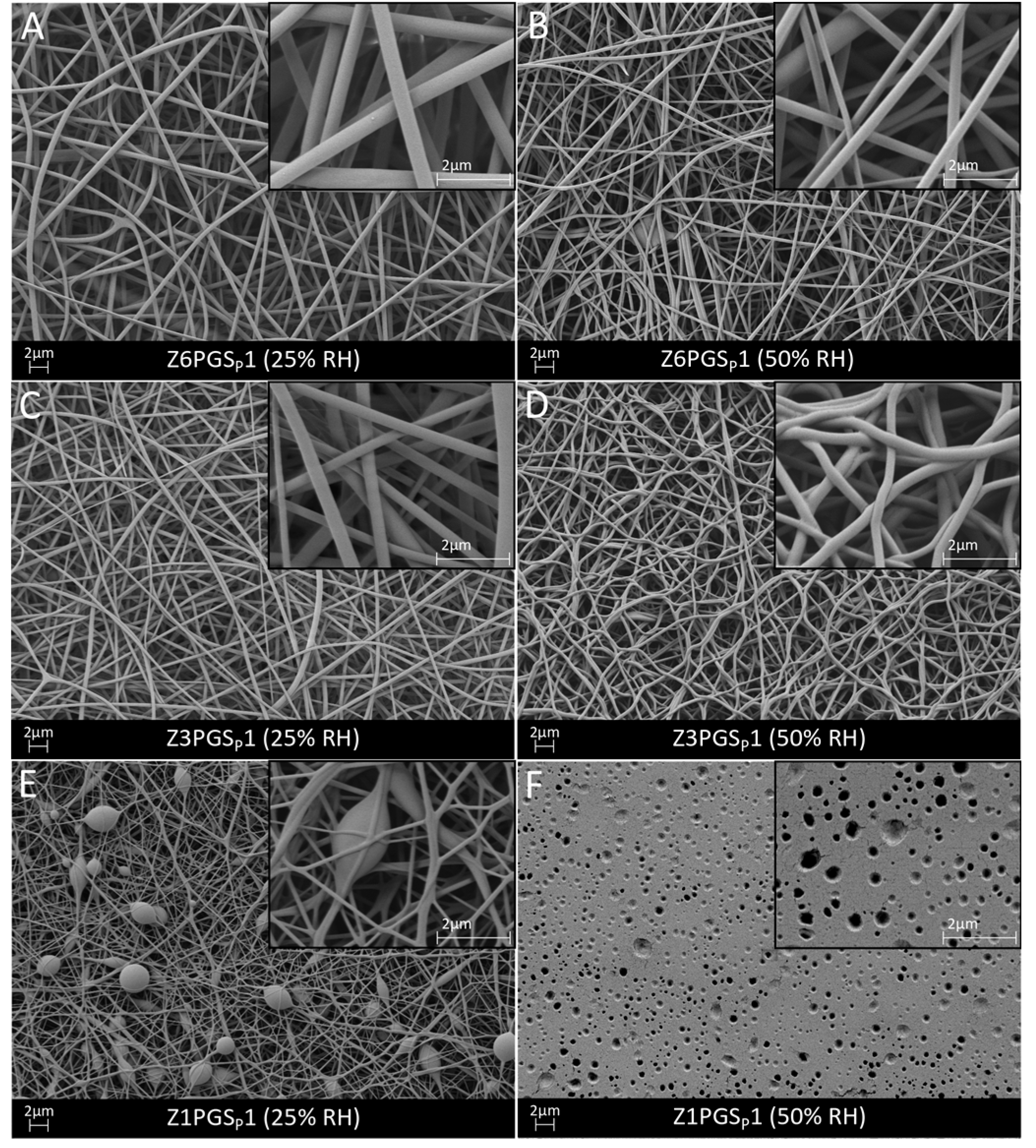
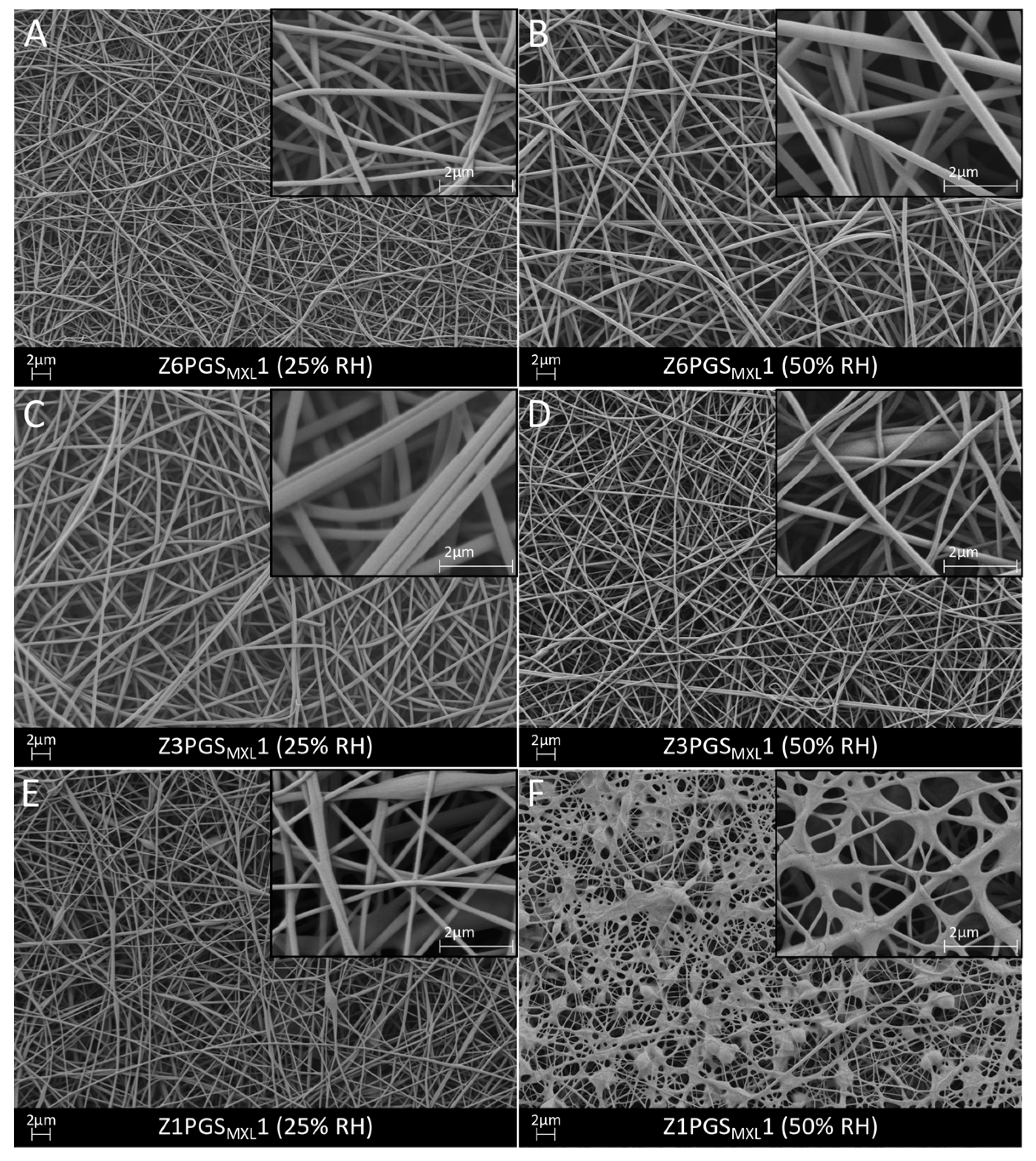
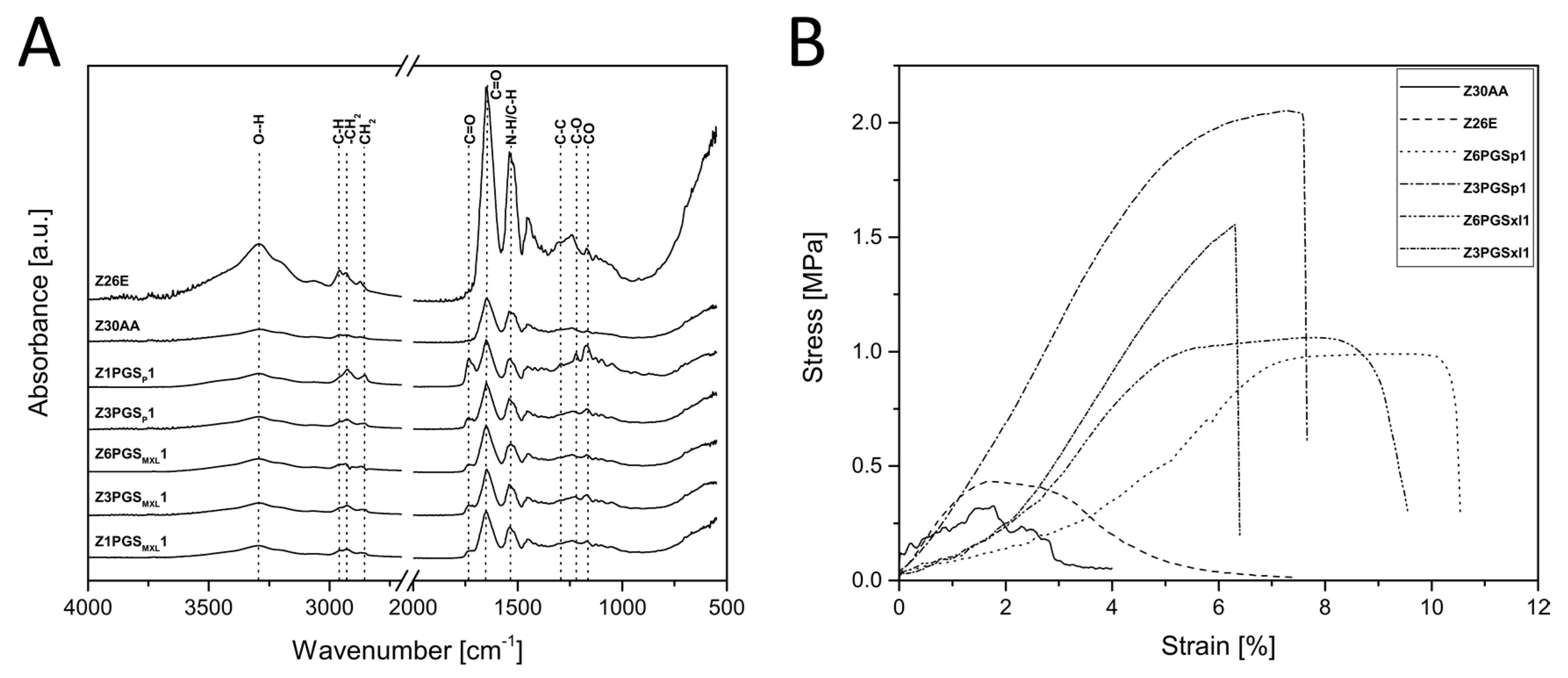


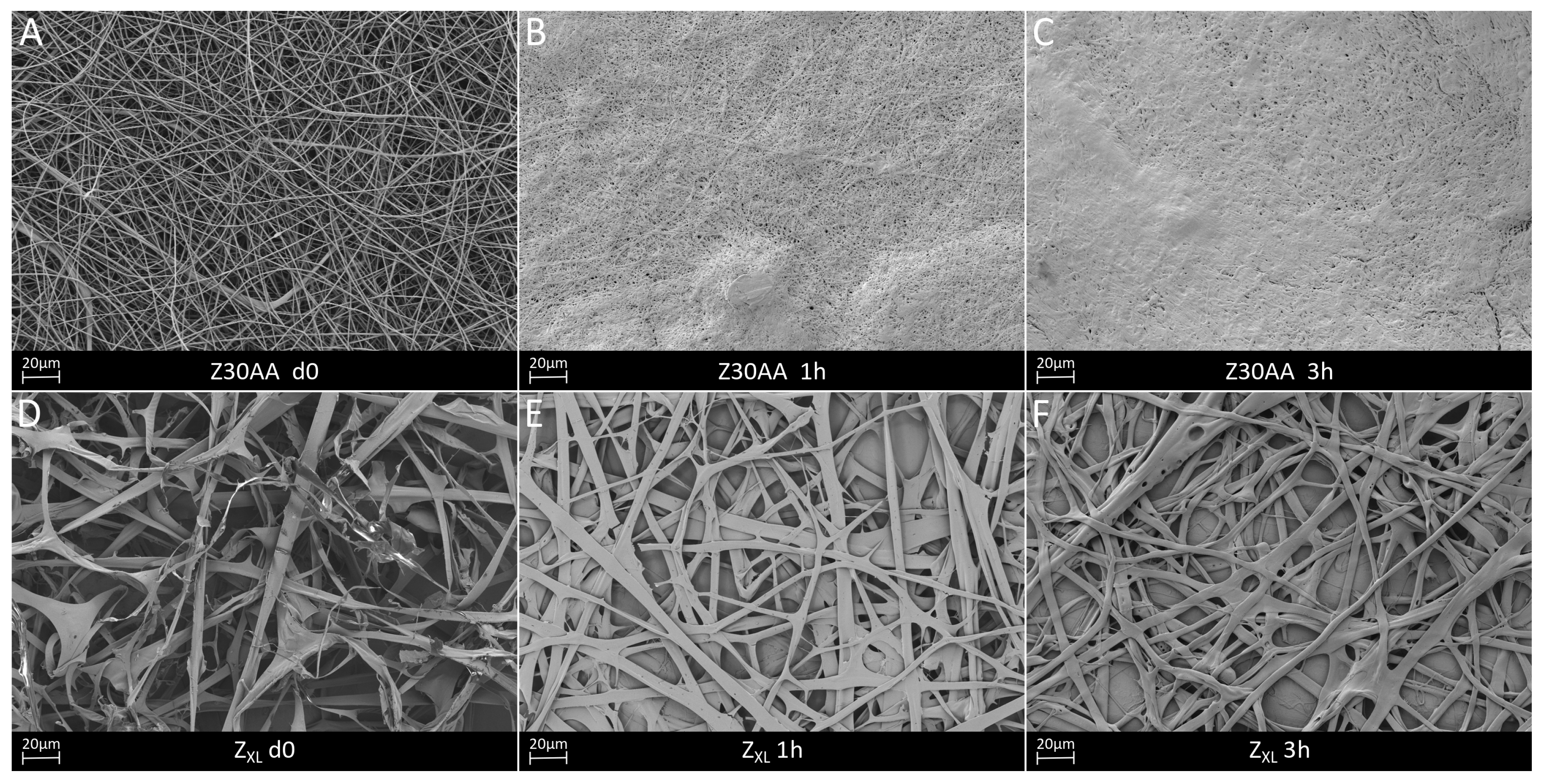
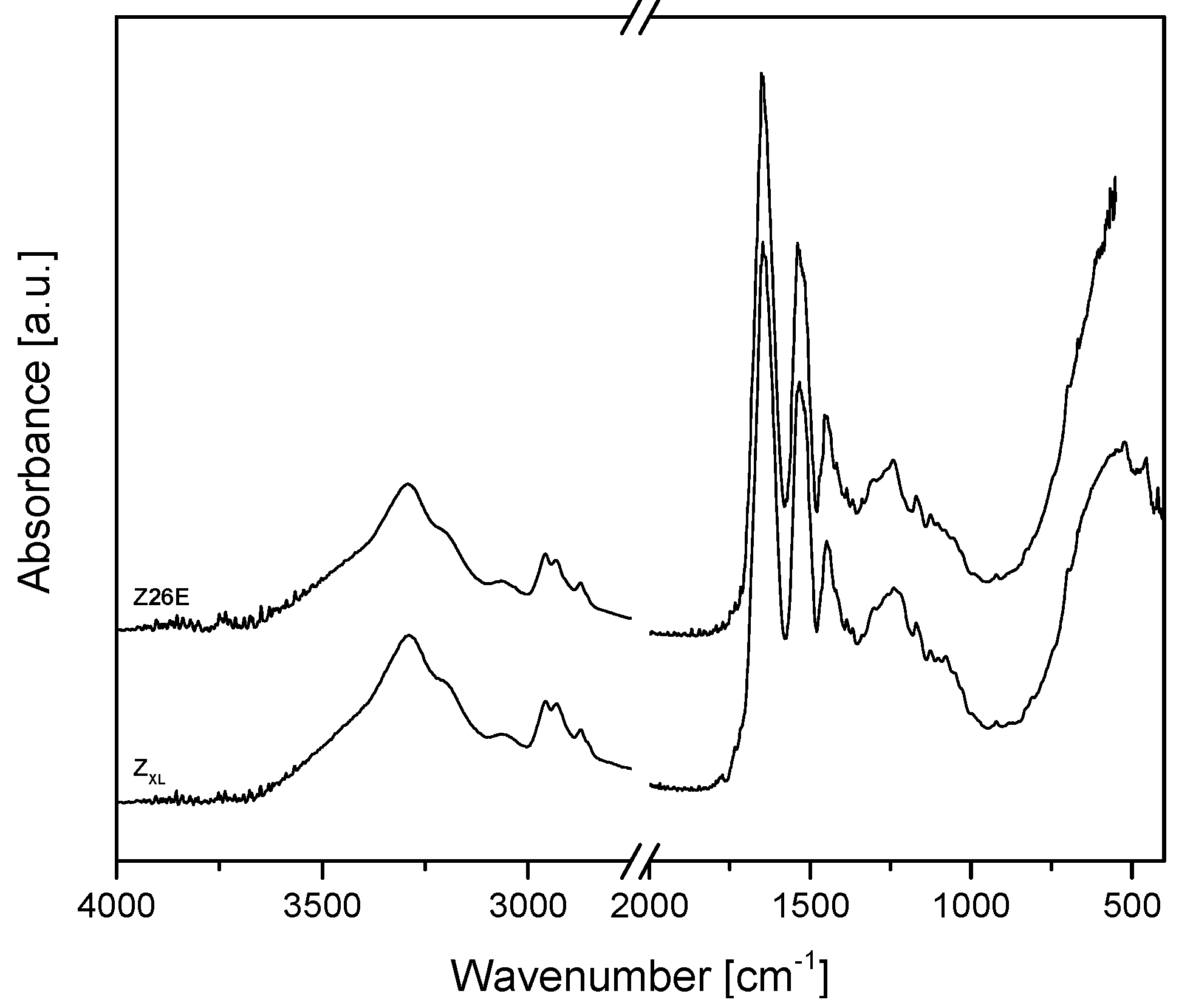
| Sample | Polymers/Ratio | Solution Concentration/Solvent System | Voltage (kV) | Tip-Target Distance (cm) | Flow Rate (mL/h) |
|---|---|---|---|---|---|
| Z30AA | Zein | 30 wt % in AcOH | 20 | 10 | 0.4 |
| Z26E | Zein | 26 wt % in EtOH | 20 | 10 | 0.7 |
| Z6PGSP1 | Zein:PGSP 6:1 | 30 wt % in AcOH | 20 | 15 | 0.3 |
| Z3PGSP1 | Zein:PGSP 3:1 | 30 wt % in AcOH | 20 | 15 | 0.3 |
| Z1PGSP1 | Zein:PGSP 1:1 | 30 wt % in AcOH | 20 | 15 | 0.2–0.3 |
| Z6PGSMXL1 | Zein:PGSMXL 6:1 | 30 wt % in AcOH | 20 | 15 | 0.3 |
| Z3PGSMXL1 | Zein:PGSMXL 3:1 | 30 wt % in AcOH | 20 | 15 | 0.3 |
| Z1PGSMXL1 | Zein:PGSMXL 1:1 | 30 wt % in AcOH | 20 | 15 | 0.3 |
| ZXL | Zein | 26 wt % in EtOH | 20 | 10 | 0.3 |
| Sample | Average Fiber Diameter (µm) | Pore Area, Min–Max (µm2) | Young’s Modulus (MPa) | Ultimate Tensile Strength (MPa) | Failure Strain (%) |
|---|---|---|---|---|---|
| Z30AA | 0.7 ± 0.2 | 0.02–18.3 | 22 ± 7 | 0.3 ± 0.1 | 2.7 ± 0.9 |
| Z26E | 0.6 ± 0.3 | 0.02–15.6 | 19 ± 9 | 0.4 ± 0.03 | 5 ± 1 |
| Z6PGSP1 | 0.3 ± 0.1 | 0.01–10.6 | 7 ± 2 | 1.0 ± 0.1 | 10 ± 1 |
| Z3PGSP1 | 0.3 ± 0.1 | 0.01–8.7 | 32 ± 10 | 2.2 ± 0.8 | 6 ± 2 |
| Z1PGSP1 | - | - | - | - | - |
| Z6PGSMXL1 | 0.3 ± 0.1 | 0.01–10.3 | 24 ± 17 | 1.2 ± 0.2 | 11 ± 4 |
| Z3PGSMXL1 | 0.2 ± 0.1 | 0.01–6.2 | 25 ± 16 | 1.4 ± 0.3 | 5 ± 1 |
| Z1PGSMXL1 | 0.09 ± 0.03 | 0.01–5.0 | - | - | - |
© 2018 by the authors. Licensee MDPI, Basel, Switzerland. This article is an open access article distributed under the terms and conditions of the Creative Commons Attribution (CC BY) license (http://creativecommons.org/licenses/by/4.0/).
Share and Cite
Vogt, L.; Liverani, L.; Roether, J.A.; Boccaccini, A.R. Electrospun Zein Fibers Incorporating Poly(glycerol sebacate) for Soft Tissue Engineering. Nanomaterials 2018, 8, 150. https://doi.org/10.3390/nano8030150
Vogt L, Liverani L, Roether JA, Boccaccini AR. Electrospun Zein Fibers Incorporating Poly(glycerol sebacate) for Soft Tissue Engineering. Nanomaterials. 2018; 8(3):150. https://doi.org/10.3390/nano8030150
Chicago/Turabian StyleVogt, Lena, Liliana Liverani, Judith A. Roether, and Aldo R. Boccaccini. 2018. "Electrospun Zein Fibers Incorporating Poly(glycerol sebacate) for Soft Tissue Engineering" Nanomaterials 8, no. 3: 150. https://doi.org/10.3390/nano8030150






